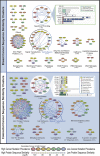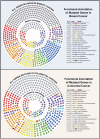A multidimensional analysis of genes mutated in breast and colorectal cancers
- PMID: 17693572
- PMCID: PMC1950899
- DOI: 10.1101/gr.6431107
A multidimensional analysis of genes mutated in breast and colorectal cancers
Abstract
A recent study of a large number of genes in a panel of breast and colorectal cancers identified somatic mutations in 1149 genes. To identify potential biological processes affected by these genes, we examined their putative roles based on sequence similarity, membership in known functional groups and pathways, and predicted interactions with other proteins. These analyses identified functional groups and pathways that were enriched for mutated genes in both tumor types. Additionally, the results pointed to differences in molecular mechanisms that underlie breast and colorectal cancers, including various intracellular signaling and metabolic pathways. These studies provide a multidimensional framework to guide further research and help identify cellular processes critical for malignant progression and therapeutic intervention.
Figures





Similar articles
-
NABC1 (BCAS1): alternative splicing and downregulation in colorectal tumors.Genomics. 2000 May 1;65(3):299-302. doi: 10.1006/geno.2000.6172. Genomics. 2000. PMID: 10857754
-
The genomic landscapes of human breast and colorectal cancers.Science. 2007 Nov 16;318(5853):1108-13. doi: 10.1126/science.1145720. Epub 2007 Oct 11. Science. 2007. PMID: 17932254
-
Integrative analysis of a cancer somatic mutome.Mol Cancer. 2007 Feb 5;6:13. doi: 10.1186/1476-4598-6-13. Mol Cancer. 2007. PMID: 17280605 Free PMC article.
-
Systematic analyses of the cancer genome: lessons learned from sequencing most of the annotated human protein-coding genes.Curr Opin Oncol. 2008 Jan;20(1):66-71. doi: 10.1097/CCO.0b013e3282f31108. Curr Opin Oncol. 2008. PMID: 18043258 Review.
-
BRCA1 gene in breast cancer.J Cell Physiol. 2003 Jul;196(1):19-41. doi: 10.1002/jcp.10257. J Cell Physiol. 2003. PMID: 12767038 Review.
Cited by
-
Integrated analysis of recurrent properties of cancer genes to identify novel drivers.Genome Biol. 2013 May 29;14(5):R52. doi: 10.1186/gb-2013-14-5-r52. Genome Biol. 2013. PMID: 23718799 Free PMC article.
-
Eph-dependent cell-cell adhesion and segregation in development and cancer.Cell Mol Life Sci. 2012 Jun;69(11):1813-42. doi: 10.1007/s00018-011-0900-6. Epub 2011 Dec 28. Cell Mol Life Sci. 2012. PMID: 22204021 Free PMC article. Review.
-
Cancer gene discovery in mouse and man.Biochim Biophys Acta. 2009 Dec;1796(2):140-61. doi: 10.1016/j.bbcan.2009.03.001. Epub 2009 Mar 12. Biochim Biophys Acta. 2009. PMID: 19285540 Free PMC article. Review.
-
Amplification of F-Actin Disassembly and Cellular Repulsion by Growth Factor Signaling.Dev Cell. 2017 Jul 24;42(2):117-129.e8. doi: 10.1016/j.devcel.2017.06.007. Epub 2017 Jul 6. Dev Cell. 2017. PMID: 28689759 Free PMC article.
-
Prioritizing disease candidate genes by a gene interconnectedness-based approach.BMC Genomics. 2011 Nov 30;12 Suppl 3(Suppl 3):S25. doi: 10.1186/1471-2164-12-S3-S25. Epub 2011 Nov 30. BMC Genomics. 2011. PMID: 22369140 Free PMC article.
References
-
- Altschul S.F., Gish W., Miller W., Myers E.W., Lipman D.J., Gish W., Miller W., Myers E.W., Lipman D.J., Miller W., Myers E.W., Lipman D.J., Myers E.W., Lipman D.J., Lipman D.J. Basic local alignment search tool. J. Mol. Biol. 1990;215:403–410. - PubMed
-
- Apweiler R., Attwood T.K., Bairoch A., Bateman A., Birney E., Biswas M., Bucher P., Cerutti L., Corpet F., Croning M.D., Attwood T.K., Bairoch A., Bateman A., Birney E., Biswas M., Bucher P., Cerutti L., Corpet F., Croning M.D., Bairoch A., Bateman A., Birney E., Biswas M., Bucher P., Cerutti L., Corpet F., Croning M.D., Bateman A., Birney E., Biswas M., Bucher P., Cerutti L., Corpet F., Croning M.D., Birney E., Biswas M., Bucher P., Cerutti L., Corpet F., Croning M.D., Biswas M., Bucher P., Cerutti L., Corpet F., Croning M.D., Bucher P., Cerutti L., Corpet F., Croning M.D., Cerutti L., Corpet F., Croning M.D., Corpet F., Croning M.D., Croning M.D., et al. The InterPro database, an integrated documentation resource for protein families, domains and functional sites. Nucleic Acids Res. 2001;29:37–40. - PMC - PubMed
-
- Ashburner M., Ball C.A., Blake J.A., Botstein D., Butler H., Cherry J.M., Davis A.P., Dolinski K., Dwight S.S., Eppig J.T., Ball C.A., Blake J.A., Botstein D., Butler H., Cherry J.M., Davis A.P., Dolinski K., Dwight S.S., Eppig J.T., Blake J.A., Botstein D., Butler H., Cherry J.M., Davis A.P., Dolinski K., Dwight S.S., Eppig J.T., Botstein D., Butler H., Cherry J.M., Davis A.P., Dolinski K., Dwight S.S., Eppig J.T., Butler H., Cherry J.M., Davis A.P., Dolinski K., Dwight S.S., Eppig J.T., Cherry J.M., Davis A.P., Dolinski K., Dwight S.S., Eppig J.T., Davis A.P., Dolinski K., Dwight S.S., Eppig J.T., Dolinski K., Dwight S.S., Eppig J.T., Dwight S.S., Eppig J.T., Eppig J.T., et al. Gene ontology: Tool for the unification of biology. The Gene Ontology Consortium. Nat. Genet. 2000;25:25–29. - PMC - PubMed
-
- Benjamini Y., Hochberg Y., Hochberg Y. Controlling the false discovery rate: A practical and powerful approach to multiple testing. J. R. Stat. Soc. [Ser A] 1995;57:289–300.
Publication types
MeSH terms
Substances
Grants and funding
LinkOut - more resources
Full Text Sources
Other Literature Sources
Medical
